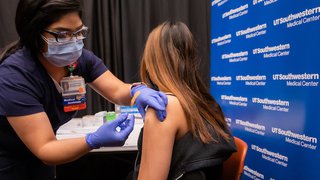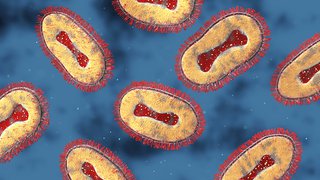Summer fun in the sun: What's safe outdoors during COVID-19?
May 22, 2020

After several months of sheltering-in-place and physical distancing, we're up against our next COVID-19 challenge – balancing the collective urge to get outside and soak up summer fun while staying safe and fending off a second wave of infections.
Texas is on a growing list of states that are gradually reopening their beaches, parks, restaurants, and movie theaters just as Memorial Day, the unofficial start of summer, arrives.
The good news is that a growing body of evidence suggests the risk of transmitting the virus outdoors is significantly lower than it is indoors. A recent study of more than 1,200 cases in 120 cities found only a single instance of COVID-19 that could be traced back to outdoor transmission.
But that doesn’t change the fact that COVID-19 is a never-before-seen respiratory virus responsible for a global pandemic and our understanding of its characteristics is in its infancy. In other words, before plunging headfirst into backyard barbecues and beach vacations, consider the known risk levels and follow some common-sense safety guidelines.

Low-to-moderate risk activities

Hiking and biking at state and national parks
Health experts around the world, including UT Southwestern sports cardiologist Ben Levine, M.D., agree that outside exercise is generally safe during the pandemic if we take steps to protect ourselves and others. Many state and national parks have reopened, at least on a partial basis. If you plan to go for a hike or exploring, go with a small group, stay six feet apart whenever possible, and avoid large crowds.
Safety tip: Carry a face mask or gaiter to pull over your nose and mouth in the event a crowd forms on the trail or at scenic stops. Wash your hands frequently or use hand sanitizer, especially if you are touching handrails or bike station tools.

Backyard barbecues and family gatherings
Limit shindigs to groups of 10 or fewer, and don't share utensils, cups, or snacks – no double-dipping! Remember that even if no partygoers are showing symptoms, someone could still be infected and can pass the virus to others.
At parties, picnics, and fireworks shows, stay six feet apart and wear masks if there's a chance you'll venture closer. Wipe down high-touch surfaces, such as patio tables.
Safety tip: Consider rescheduling large family reunions until late summer. Try to implement a "sorry, no hugging or handshakes" policy. People at high risk for infection, such as older family members or those with underlying health conditions such as diabetes, should be extra careful to follow these precautions.
Swimming and pool parties

Backyard pool parties with people from your household are generally safe. Coronavirus will not spread in a well-maintained pool. The risk comes from the people in the pool. You can invite the neighbors, but try to stay six feet apart, have conversations across the pool rather than right next to each other, and cap the total number of guests at 10. Lap swimming at the gym is also relatively low risk. It's when you get into crowds at a public pool that your risk increases.
Safety tip: Wear a mask in crowded areas. If the community pool is packed, try coming back another day.

Moderate-risk activities

Eating at restaurants
It's great to support local restaurants, which are opening to 50% capacity in Texas at the time of this writing. But COVID-19 can live on high-touch items such as menus and condiment bottles for up to three days on plastic surfaces. Restaurant staff should be wearing masks and cleaning high-touch surfaces regularly. You can boost their efforts by wiping items with a disinfecting wipe yourself before use.
Patio dining will likely be safer if you follow physical distancing recommendations. But the same cleaning concepts apply to high-touch surfaces.
Safety tip: Keep your group to fewer than 10. Wear a face mask before and after the meal. Sit with at least one table between you and the next group of diners. Don't worry about wearing gloves – you'll likely touch your face or forget to take them off before entering your car or home, and the pathogens can live on the surface of the gloves. Instead, bring hand sanitizer and use it regularly.

Visiting the beach
Why are state parks and trails safer than the beach? It's all about wide open spacing. On the beach, people tend to crowd together on blankets, towels, chairs, or the cabana.
Safety tip: Skip the sun-and-sand if the beach is busy. If you choose to go, wear a face mask, use hand sanitizer, and carry disinfecting wipes to sanitize community chairs before use. Avoid community beach toys and floaties – bring your own instead.

Going to the movies
The Memorial Day weekend blockbusters have all been delayed thanks to COVID-19, but drive-in movies are making a comeback because they are a safer option than sitting shoulder-to-shoulder inside a megaplex.
Safety tip: If you choose to go to the theater, wear a mask and carry hand sanitizer. Sit at least six feet apart if you can – if nothing else, physical distancing is a good excuse not to share your popcorn.

High-risk activities

Amusement and water parks
The Centers for Disease Control and Prevention (CDC) still recommends avoiding amusement parks and playgrounds for now to avoid infection from high-touch surfaces. Most large amusement parks, such as Six Flags Over Texas, remain closed. But attractions such as the Dallas Zoo and the Fort Worth Zoo are scheduled to reopen at the end of May. Some water parks are planning to reopen in mid-June, pending state guidance.
Safety tip: If you choose to go, avoid crowds and be sure to wash your hands regularly, even if you are playing in the water. Wear a mask when practical and avoid sharing drinks or snacks.

Traveling for vacation
Flying while practicing physical distancing is not impossible. However, many risk factors will be out of your control, such as the number of passengers on a flight. Driving may be safer, though you'll have to make occasional pit stops at public rest areas or gas stations and navigate a hotel stay.
Safety tip: Consider traveling more locally this summer. For example, I was going to take my family to Costa Rica, but we changed our plans and will now be taking a road trip instead. When you go, carry hand sanitizer, wear a face mask, and avoid crowds whenever possible.

Summer camp
Kids who've been cooped up all spring may be looking forward to camp, but sending your child might be nerve wracking for both of you. It's important to check the occupancy of the camp's sleeping, living, and eating areas, as well as its disinfecting procedures.
Safety tip: Along with bug spray and sunscreen, pack extra disinfecting wipe, hand sanitizer, and face masks for your child. Don't hesitate to ask about the camp's medical capabilities, including screening protocols and access to emergency care.
Sporting events and concerts
Baseball, softball, soccer, golf, tennis…boy, we've missed our sports. And who wouldn't love a rocking stadium concert right now? Playing non-contact sports with friends should be relatively safe because you can observe physical distancing (ride in separate golf carts or walk; use hand sanitizer and wipes). Unfortunately, close quarters in the stands at a sporting event or concert may have to wait until the various leagues and venues establish appropriate physical distancing and safety guidelines.
Safety tip: If watching online or on TV just won't cut it, check the stadium's rules on carrying in wipes and hand sanitizer. Spread out whenever possible, wear a face mask, wash your hands, and don't share snacks or beverages.
Will warm weather stop the spread of COVID-19?
While some research suggests that warmer temperatures may slow the spread of the virus, infectious disease experts anticipate the virus will continue to spread. If it does slow, it is likely that the virus will return in the fall or winter.
COVID-19 is transmitted through small respiratory droplets in the air and on surfaces. Outside, people have more room to spread out. And when you factor in air movement and humidity, the droplets are more likely dissipate more quickly outside than indoors.
We've all made sacrifices this spring, and it's worked. Modeling data show that shelter-in-place and physical distancing protocols have been effective. Let's not waste all that effort by inviting a second wave.
Over the summer, we must balance our natural need for human contact with protecting ourselves and each other. Enjoy the warmer weather this summer. And remember to do your part in contributing to a safer, healthier North Texas.
To visit with a respiratory doctor, call 214-645-8300 or request an appointment online.











